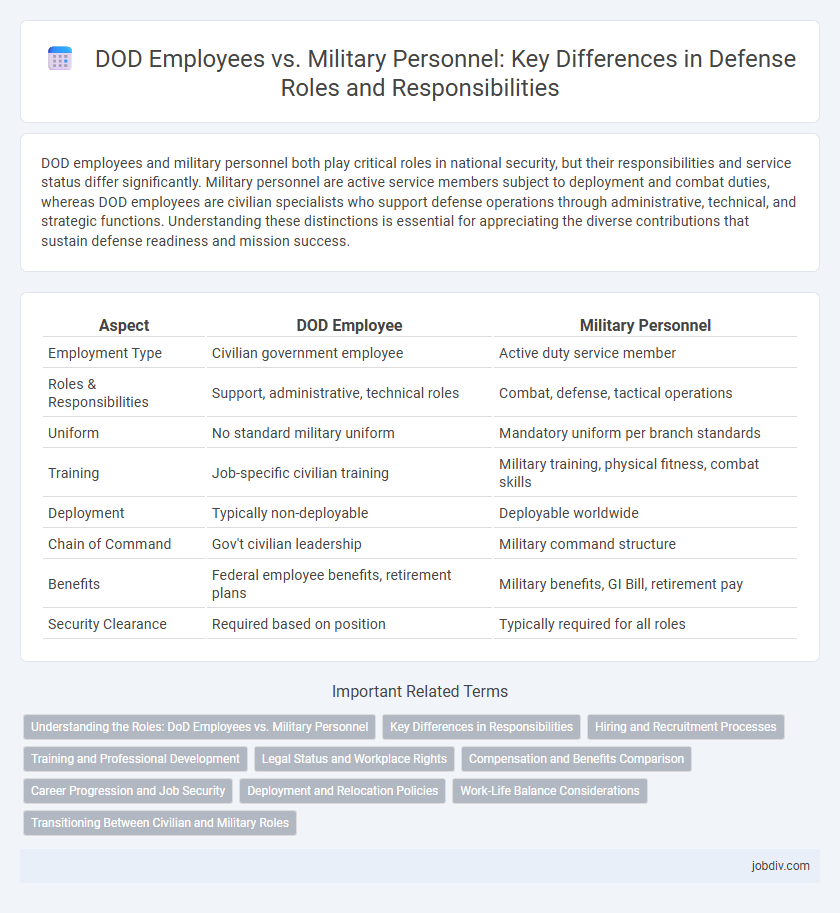DOD employees and military personnel both play critical roles in national security, but their responsibilities and service status differ significantly. Military personnel are active service members subject to deployment and combat duties, whereas DOD employees are civilian specialists who support defense operations through administrative, technical, and strategic functions. Understanding these distinctions is essential for appreciating the diverse contributions that sustain defense readiness and mission success.
Table of Comparison
| Aspect | DOD Employee | Military Personnel |
|---|---|---|
| Employment Type | Civilian government employee | Active duty service member |
| Roles & Responsibilities | Support, administrative, technical roles | Combat, defense, tactical operations |
| Uniform | No standard military uniform | Mandatory uniform per branch standards |
| Training | Job-specific civilian training | Military training, physical fitness, combat skills |
| Deployment | Typically non-deployable | Deployable worldwide |
| Chain of Command | Gov't civilian leadership | Military command structure |
| Benefits | Federal employee benefits, retirement plans | Military benefits, GI Bill, retirement pay |
| Security Clearance | Required based on position | Typically required for all roles |
Understanding the Roles: DoD Employees vs. Military Personnel
DoD employees provide critical civilian support in administrative, technical, and logistical roles that sustain military operations, ensuring continuity and expertise beyond active combat duties. Military personnel engage directly in defense missions, combat readiness, and tactical execution, embodying the operational core of the Department of Defense. Understanding the distinct but complementary functions of DoD employees and military personnel is essential for optimizing resource allocation and mission success within national security frameworks.
Key Differences in Responsibilities
DOD employees primarily support defense operations through specialized administrative, technical, and logistical roles, while military personnel engage directly in combat, tactical missions, and national security enforcement. Military personnel undergo rigorous physical training and follow strict command structures for operational readiness, whereas DOD employees focus on policy implementation, intelligence analysis, and infrastructure management. These distinct responsibilities ensure that DOD employees provide essential support functions that enable military personnel to execute defense strategies effectively.
Hiring and Recruitment Processes
The Department of Defense (DoD) hiring process for civilian employees involves structured assessments, background checks, and compliance with federal employment regulations, emphasizing specialized skills for non-combat roles. Military personnel recruitment focuses on meeting physical fitness standards, aptitude tests, and commitment to service obligations, tailored to ensure readiness for active duty. Both processes prioritize security clearances but differ significantly in eligibility criteria, training pathways, and career development frameworks.
Training and Professional Development
DOD employees undergo specialized training tailored to support civilian roles, emphasizing technical skills, policy expertise, and administrative functions critical to defense operations. Military personnel receive rigorous, mission-focused training designed to enhance combat readiness, leadership, and operational effectiveness across diverse environments. Continuous professional development for both groups integrates evolving defense strategies and technologies to maintain peak performance and adaptability.
Legal Status and Workplace Rights
Department of Defense (DOD) employees hold civilian status under federal employment law, granting them protections such as collective bargaining rights and eligibility for federal employee benefits. Military personnel, governed by the Uniform Code of Military Justice (UCMJ), operate under a distinct legal framework that limits certain civilian workplace protections but emphasizes military discipline and chain of command authority. The differentiation in legal status directly affects workplace rights, grievance procedures, and job security measures between DOD civilians and uniformed service members.
Compensation and Benefits Comparison
DOD employees receive standardized federal civilian pay scales, with access to comprehensive benefits including federal retirement plans, health insurance, and paid leave, while military personnel are compensated through rank-based pay with additional allowances like housing and subsistence. Military members benefit from unique entitlements such as combat pay, hazardous duty incentives, and comprehensive TRICARE healthcare coverage, which often surpass civilian offerings. Both groups have access to retirement systems, but military pensions typically depend on years of service and deployment history, providing distinct long-term financial security compared to civilian federal retirement plans.
Career Progression and Job Security
DOD employees typically experience steady career progression through structured civilian pay grades and specialized skill development programs, ensuring long-term job security within federal employment. Military personnel engage in rank-based advancement influenced by performance, time in service, and leadership potential, with career opportunities tied to operational readiness and deployment cycles. While military careers may involve frequent relocations and active duty demands, the DOD civilian workforce benefits from stable work environments and comprehensive federal employment protections.
Deployment and Relocation Policies
Deployment policies for DOD employees typically involve temporary assignments supporting military operations or base functions without combat deployment, whereas military personnel face mandatory deployments with fixed durations and predefined rotation cycles. Relocation policies for DOD civilians emphasize job continuity and family considerations, often granting relocation allowances and relocation rights tied to permanent change-of-station orders. Military personnel relocation is governed by Permanent Change of Station (PCS) orders with strict timelines and mandatory movement to assigned duty stations, primarily driven by operational needs and force readiness.
Work-Life Balance Considerations
DOD employees often experience more predictable work hours and greater access to flexible schedules, enhancing work-life balance compared to military personnel whose duties may involve extended deployments and irregular shifts. Military personnel face unique challenges such as frequent relocations and mission-driven demands that impact family time and personal commitments. Understanding these differences is essential for tailored support programs that address the distinct work-life balance needs within the Department of Defense workforce.
Transitioning Between Civilian and Military Roles
Transitioning between DOD employee and military personnel roles involves navigating distinct career paths within the Department of Defense, each with unique responsibilities and regulations. Civilian employees often bring specialized expertise that supports military operations, while service members may leverage military training and leadership skills when moving into civilian roles. Effective transition programs and policies facilitate skill alignment, credential recognition, and continuity of mission-critical functions across both civilian and uniformed positions.
DOD Employee vs Military Personnel Infographic

 jobdiv.com
jobdiv.com